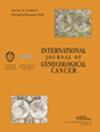Association between Silva pattern-based classification and endocervical adenocarcinoma: a systematic review and meta-analysis
IF 4.1
2区 医学
Q1 OBSTETRICS & GYNECOLOGY
引用次数: 0
Abstract
Objective To determine the relationship between the Silva pattern-based classification system and endocervical adenocarcinoma. Methods The PubMed, Embase, Central Cochrane Library, and Web of Science databases were systematically searched for studies that investigated the correlation between the Silva classification system and the oncology prognosis or pathological features of endocervical adenocarcinoma, published in the period from January 2013 to March 2024. Results A total of 19 eligible studies including 3122 cases were included in this systematic review and meta-analysis. The combined death rate in the Silva A, Silva B, and Silva C patterns was 0% (95% CI 0.0% to 0.4%), 2.6% (95% CI 0.4% to 5.9%), and 14.0% (95% CI 9.4% to 19.2%), respectively; the combined recurrence rate in the Silva A, Silva B, and Silva C patterns was 0.1% (95% CI 0.0% to 1.2%), 5.1% (95% CI 1.6% to 10.0%), and 19.4% (95% CI 14.7% to 24.4%), respectively; the combined lymphovascular invasion rate in the Silva A, Silva B, and Silva C patterns was 0% (95% CI 0.0% to 0.5%), 21.0% (95% CI 16.9% to 25.4%), and 58.8% (95% CI 50.1% to 67.3%), respectively; and the combined International Federation of Gynecology and Obstetrics (FIGO) I rate in the Silva A, Silva B, and Silva C patterns was 99.3% (95% CI 97.6% to 100%), 93.7% (95% CI 86.4% to 98.7%), and 82.4% (95% CI 74.9% to 88.9%), respectively. Conclusion Our study found that Silva A was negatively correlated with death rate, while Silva C was positively correlated. There was no correlation regarding the death rate for Silva B. Based on these findings, it is suggested that the Silva pattern-based classification system can predict the prognosis of human papillomavirus (HPV)-related endocervical adenocarcinoma and assist in guiding patient treatment. Data are available in a public, open access repository. In accordance with the journal’s guidelines, we will provide our data for independent analysis by a selected team by the Editorial Team for the purposes of additional data analysis or for the reproducibility of this study in other centers if such is requested.基于席尔瓦模式的分类与宫颈内膜腺癌之间的关系:系统回顾与荟萃分析
目的 确定基于席尔瓦模式的分类系统与宫颈内膜腺癌之间的关系。方法 在PubMed、Embase、Cochrane中央图书馆和Web of Science数据库中系统检索2013年1月至2024年3月期间发表的调查席尔瓦分类系统与宫颈内膜腺癌的肿瘤预后或病理特征之间相关性的研究。结果 本次系统回顾和荟萃分析共纳入了19项符合条件的研究,包括3122个病例。Silva A、Silva B 和 Silva C 三种模式的综合死亡率分别为 0% (95% CI 0.0% to 0.4%)、2.6% (95% CI 0.4% to 5.9%) 和 14.0% (95% CI 9.4% to 19.2%)。2%);席尔瓦A、席尔瓦B和席尔瓦C模式的合并复发率分别为0.1%(95% CI 0.0%至1.2%)、5.1%(95% CI 1.6%至10.0%)和19.4%(95% CI 14.7%至24.4%);Silva A、Silva B和Silva C模式的合并淋巴管侵犯率分别为0%(95% CI 0.0%至0.5%)、21.0%(95% CI 16.9%至25.4%)和58.8%(95% CI 50.1%至67.国际妇产科联盟 (FIGO) I 级综合比率在 Silva A、Silva B 和 Silva C 模式中分别为 99.3% (95% CI 97.6% to 100%)、93.7% (95% CI 86.4% to 98.7%) 和 82.4% (95% CI 74.9% to 88.9%)。结论 我们的研究发现,Silva A 与死亡率呈负相关,而 Silva C 则呈正相关。基于这些发现,我们认为基于席尔瓦模式的分类系统可以预测与人类乳头瘤病毒(HPV)相关的宫颈内膜腺癌的预后,并有助于指导患者的治疗。数据可在公开、开放的资源库中获取。根据期刊指南,我们将提供我们的数据,供编辑部选定的团队进行独立分析,以便进行额外的数据分析,或根据要求在其他中心重现这项研究。
本文章由计算机程序翻译,如有差异,请以英文原文为准。
求助全文
约1分钟内获得全文
求助全文
来源期刊
CiteScore
6.60
自引率
10.40%
发文量
280
审稿时长
3-6 weeks
期刊介绍:
The International Journal of Gynecological Cancer, the official journal of the International Gynecologic Cancer Society and the European Society of Gynaecological Oncology, is the primary educational and informational publication for topics relevant to detection, prevention, diagnosis, and treatment of gynecologic malignancies. IJGC emphasizes a multidisciplinary approach, and includes original research, reviews, and video articles. The audience consists of gynecologists, medical oncologists, radiation oncologists, radiologists, pathologists, and research scientists with a special interest in gynecological oncology.

 求助内容:
求助内容: 应助结果提醒方式:
应助结果提醒方式:


